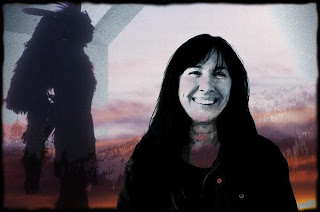 |
| Pamela Roberts |
Previous to that time, when I was about 14 years old (1969), I was studying privately with Vivian King at Pacific Lutheran University (PLU) in Tacoma, Washington when Eva's and my path crossed. Gabor Rejto came up from the University of Southern California to give a cello master class at PLU - Vivian King was one of his former students. I played for Rejto and Eva attended the master class with one of her star pupils - this was the first time that Eva heard me play. I didn't see her again until I was 20 years old when I auditioned to enter the UW - and I am sure that she did not remember me from the master class six years before.
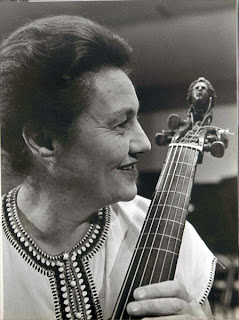 |
| Eva Heinitz |
When I was done, Eva was flabbergasted with the quality of my performance and said so. For her at that moment, I was a talent who had "come out of nowhere," which created a dilemma because she already had a top student who was a senior the year I entered the UW. After hearing me play, Eva knew that I should sit "first chair" but she wanted to honor the position of her senior student, so she worked it out by having us be "co-principals." I was given a full scholarship for five years while I studied for my cello performance degree and Masters in Music.The Brechemin Family Foundation was the primary source of my support during these years of study.
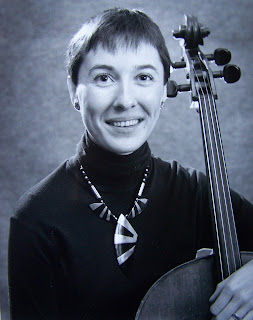 |
| Pamela Roberts |
 |
| Dr. Stanley Chapple |
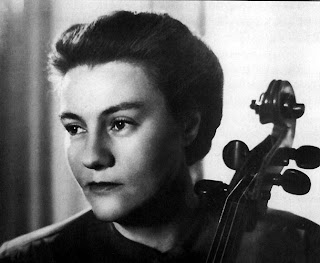 |
| Eva Heinitz |
Eva had many stories to tell about her flight from Germany, how she went to Paris, London and eventually to the United States and how many other musicians helped her along the way to protect her. She told one hilarious story about practicing in a flat when she was a refugee, when she was constantly harassed by her neighbors about making noise. She had to choose her practice times carefully so as not to bother anyone. She felt criticized and unprotected. She had next to nothing in the way of furniture - just an open flat with hardwood floors. One day, a cockroach came out of the wall and started to move towards her while she played. When she stopped, it stopped. When she played, it continued to move towards her. She said, "Everyone's a music critic - even the cockroach." These were the types of things that kept her amused while she waited for the opportunity to again become an active musician and to perform publicly.
I remember that Eva would tell me that, "There are Nazis everywhere." As a young woman, I thought that she was a bit paranoid when she would say this. Later I married a Jewish man and with more age and experience I realized that she wasn't exaggerating. I believe that Eva's father was Jewish, her mother was not - thus Eva would say that she was about half Jewish - 51% in fact. Her sense of humor was pervasive and she thought metaphorically as a rule. She was a highly intelligent person - in fact, a real genius - and this came out strongly through her remarkable sense of humor.
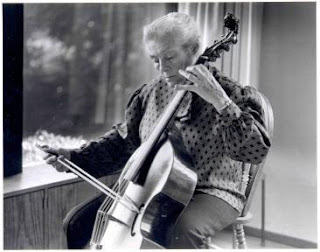 |
| Eva Heinitz |
Eva was briefly married in her early twenties. I believe that she divorced after a very short period and never remarried. Later, when her name was featured in the Who's Who in America, it was mentioned in the text that she had been married and it even stated the name of the man in the entry. Eva was livid when she found out that this had been included in the text about her life and her professional contributions. She felt that it sent a message to the world that her contributions in music were worth nothing unless she had a man in her life. She showed the book to me one day and we laughed together about how ridiculous this was.
When Eva eventually found the love of her life, her Goffriller cello, and was preparing to purchase it, there were wealthy benefactors around her, who could have helped her procure the instrument, but who would not lift a finger to help. She said that she threw all modesty aside and begged everyone she knew to help her buy the cello and she succeeded primarily because her less wealthy friends all pitched in. These were life lessons that Eva was teaching me. She was not as a rule fond of wealthy people - she found them as a group to be selfish. She described playing for a wealthy woman once, who refused to allow Eva to eat anything during the time in which Eva was in her home playing for a private party. Eva had been playing for so long that she was getting faint for lack of nourishment. She went into the kitchen to find anything that she could to eat and ended up finding some sugar cubes in a cupboard and she ate them so that she could finish the performance. These types of stories were told to me to help prepare me for the working world of music so that I would not be deterred from performing under tough circumstances.
 |
| Eva Heinitz |
(I had the honor of playing the Chopin Sonata for cello and piano for Janos Starker once during a master class at the UW - he paid me the biggest compliment when I finished, saying "What am I supposed to say? Sometimes all I can do is admire." Of course, he then went on to give me constructive criticism!)
Eva announced her retirement from the UW to me during a private lesson - this was before my degree was completed. I broke down crying and she was beside herself. She said that I was the only student who "gave a damn" that she was retiring. I told her how disappointed I was and that I had no interest in studying with anyone but her. She agreed to let me study privately with her as long as I didn't tell anyone because she didn't want to undermine Toby Saks as the new cello teacher at the UW.
And so began my new experience with Eva as I took two lessons each week, one with Eva on the weekend and one with Toby during the week over the span of several years. I learned so much from both of them. I eventually started to also study gamba with Eva and was privileged to play concerts with her and Peter Hallock, harpsichordist at St. Marks Cathedral in Seattle. Eva always kept me laughing, with her terrific sense of humor. She would say things like, "Why do they play it so slowly? You have to take a bus from one note to the next!" Or, "Elgar's music - it's like a big piece of English toffee - thick and sticky and it lasts forever." She always said that her students might not be the best technical cello players, "but they have good taste." I studied with Eva during the whole "back to the earth" era of the Vietnam War. Most of us young women did not wear much makeup during those times. Eva would mention that I looked "tired" when I would come to my lessons without any makeup on, but if I put on a little rouge before my lesson, she always would say how "rested" I looked - this got to be a little game for me.
| Pamela Roberts |
I came from a poor family, with no real background in music. My father was a diesel mechanic - he was Blackfeet Indian and had grown up on an Indian reservation in Red Mesa, Colorado and my mother was a housewife, who had come out of abject poverty in Appalachia. However, my mother loved classical music and she and my father were supportive of my wish to perform as a cellist. Referring to this background one day, Eva said, "You can never predict where talent will come from." Eva was sensitive to my financial situation and always generous with me about paying for lessons and such - she wanted to teach me and we were always able to negotiate a price that I could afford.
I became a "helper" to Eva at the same time as I performed for fifteen years as a professional cellist in Seattle and elsewhere. I used to drive her on errands - always at 10 am because she knew that was the time of day when the highways were least congested. She was a tremendous influence on my life and my music. She devoted her entire life to music and I was fortunate to be involved and immersed in that with her for many years.
Eva was a real task master, but if one wanted to play professionally, there was no other experience that would challenge you more than studying with Eva. I practiced regularly about 7 hours a day and yet once when I was preparing to play the Dvorak concerto with an orchestra, Eva heard me play the beginning of the slow movement and she shouted, "This is not a kindergarten!" I was hurt and started to tear up, and she ran into the kitchen to get cookies and tea to make it up to me! Despite all these dramas, however, I received a standing ovation for the performance and learned so much from her in the process - especially about the finesse of the use of the bow and phrasing. Eva hated it when string players "sawed their bows back and forth" - she said it was like they were trying to cut a log or something. She was a stickler for finesse with the bow and that each stroke was planned out carefully - some were full strokes, others were a half or quarter stroke of the bow - depending on the phrasing of the music.
Eva was a musician's musician. It's not only that she was exacting, but her music was outside of this world. Her musical understanding took us into a realm that most of us never touch. The expression was sublime. The pathos of it could make you breathless. If a musician was unsure of themselves then she was not the one to go to. She was as high a level musician as you could study with and if you wanted to get into her sphere then you had to be prepared for the energy that came with it. Her sarcastic sense of humor was hilarious, but I can certainly understand how it must have felt to be the target of that humor when Eva was not pleased with something. One could say that she did not suffer fools gladly. She spoke in a manner that captured the essence of her point with humor. This made it memorable.
Part of Eva's musical gift came from her early piano training. She had a firm harmonic sense that guided her melodic playing as a string musician. The sensitive and thoughtful use of her bow was legendary. She heard everything in the orchestra, piano parts, the ensemble. It was a "whole" that came together and she was attuned to every detail of the music. Her music created a 4th dimension - it was ethereal. For those students who could understand her, it was the greatest gift imaginable.
I last saw Eva in 1984 when I took her out to lunch for her to see my newborn daughter. She was obviously jealous, which was just like Eva. Her passion for the music came above everything and I know she was upset that I had gone out, gotten married and now had a baby and that that had just ruined everything! It was so funny to see her reactions, but at the same time I so appreciate who she was - she was the real thing in a highly dedicated musician. It was all about the music.
I was later injured in a car wreck and had to stop playing cello because of my injuries. I became a public school teacher and a master, working with diverse learners and at-risk youth. I became a principal in Seattle and then a faculty member with Washington State University assigned to work with youth and families in Jefferson County on the Olympic Peninsula. Within the context of my work for WSU I became an accomplished filmaker and website designer. After retiring from WSU I became the Director of Education at the Northwest School of Wooden Boatbuilding in Port Hadlock, Washington. I am still a highly dedicated person in my profession and those life skills that I learned under Eva's guidance continue to benefit me and our world, but just in a different way than through music.
Eva will always be a special part of my life. As it is now 2018 and I am fully retired, I am hoping to give it another try on the instrument just for fun - I also want to continue to teach some students on cello because I want the legacy of Eva's teaching and her musicianship to be passed on to the next generation of musicians.
Update: It's October 2018 and after 6 months of physical therapy I am playing my cello again! I wish Eva was here to see this. I'll write updates as things proceed, but it looks like I'll be performing recitals again after 35 years away from my cello. I am 63 years old and starting another adventure - stay tuned!
Pamela Roberts
pamelaroberts1@gmail.com
360-765-0124
https://archive.org/details/pacifica_radio_archives-AZ1762
http://www.interlude.hk/front/forgotten-cellists-xiv-eva-heinitz/
https://en.wikipedia.org/wiki/Eva_Heinitz
http://www.orpheon.org/OldSite/Documents/evaheinitz.htm
http://www.cello.org/heaven/bios/heinitz.htm
http://www.cello.org/Newsletter/Articles/heinitz.htm
http://community.seattletimes.nwsource.com/archive/?date=20010402&slug=obit02m
http://www.amazon.com/The-Art-Viola-Gamba-Heinitz/dp/B005F153QK
http://newspaperarchives.vassar.edu/cgi-bin/vassar?a=d&d=miscellany19480317-01.2.7#
https://csoarchives.wordpress.com/tag/eva-heinitz/
http://staff.washington.edu/noreen/viol/focusviol.shtml
http://www.nytimes.com/2001/04/22/classified/paid-notice-deaths-heinitz-eva.html
http://www2.kuow.org/program.php?id=22729
https://www.discogs.com/artist/3065283-Eva-Heinitz
https://wikivividly.com/wiki/Eva_Heinitz
https://academic.oup.com/mq/article-abstract/XL/1/136/1203058?redirectedFrom=fulltext
https://digital.lib.washington.edu/researchworks/handle/1773/27880
http://honkingduck.com/discography/artist/eva_heinitz_viola_da_gamba_j._fournier_violin_g._figueroa_viola_p._fournier_cello_
http://music.indiana.edu/giving/scholarships/scholarships-heinitz.shtml
http://data.bnf.fr/fr/14186281/eva_heinitz/
https://books.google.com/books?id=r11jLQ0R2LsC&pg=PA122&lpg=PA122&dq=eva+heinitz&source=bl&ots=XYjjNfWSvy&sig=ITWipg-wQv89-lbqC0U4U_MKAJk&hl=en&sa=X&ved=0ahUKEwjXr8qy7q7bAhU0oFsKHVPlCMc4HhDoAQgoMAA#v=onepage&q=eva%20heinitz&f=false
https://www.gettyimages.com/detail/news-photo/heinitz-eva-cellistin-1930foto-umbo-dephot-news-photo/541033753#/heinitz-eva-cellistin-1930foto-umbo-dephot-picture-id541033753
https://www.geni.com/people/Eva-Heinitz/6000000039389522584
https://books.google.com/books?id=Nx9WDwAAQBAJ&pg=PT310&lpg=PT310&dq=EVA+HEINITZ&source=bl&ots=vnnzbA_5nH&sig=CrbA3j9yJaim1wcwT5EUUg7VgsE&hl=en&sa=X&ved=0ahUKEwi-5922867bAhUSOH0KHZb8ALI4HhDoAQgyMAM#v=onepage&q=EVA%20HEINITZ&f=false
https://books.google.com/books?id=WVTSGoGfmuMC&pg=PA318&lpg=PA318&dq=EVA+HEINITZ&source=bl&ots=qmY39Lu_Ei&sig=fZSbApJOJ2bZAvlJhsg9vQN0MrM&hl=en&sa=X&ved=0ahUKEwi-5922867bAhUSOH0KHZb8ALI4HhDoAQg1MAQ#v=onepage&q=EVA%20HEINITZ&f=false
https://www.jstor.org/stable/739715?seq=1#page_scan_tab_contents
https://www.gva.be/cnt/oid102455/archief-eva-heinitz-grande-dame-du-violoncelle-overleden
https://www.nytimes.com/1939/01/30/archives/classical-music-by-new-friends-stradivarius-group-feature-two.html
https://books.google.com/books?id=GevRpPGRcoYC&pg=PA103&lpg=PA103&dq=EVA+HEINITZ&source=bl&ots=2hb185LtMf&sig=5W_PN3hXYpJaqTAes1hHPqp5COc&hl=en&sa=X&ved=0ahUKEwi-5922867bAhUSOH0KHZb8ALI4HhDoAQhEMAg#v=onepage&q=EVA%20HEINITZ&f=false
https://www.gso.se/goteborgs-symfoniker/arkiv/?soloistId=5201
https://digital.lib.washington.edu/researchworks/handle/1773/34268
http://www.charm.rhul.ac.uk/discography/browse/browse_performer_e_52.html
http://www.realmac.info/muses.htm
https://www.voyagerrecords.com/SeaMet.htm
https://www.theguardian.com/music/2014/jan/16/maria-lidka
Sister's obituary
http://www.tayvaughan.com/people/weil.html
http://www.namenfinden.de/s/eva+heinitz
Background image by Lyonel Feininger, German-American Expressionist painter. Feininger was one of Eva's favorite artists - in fact she had some of his original paintings on the walls of her living room.
